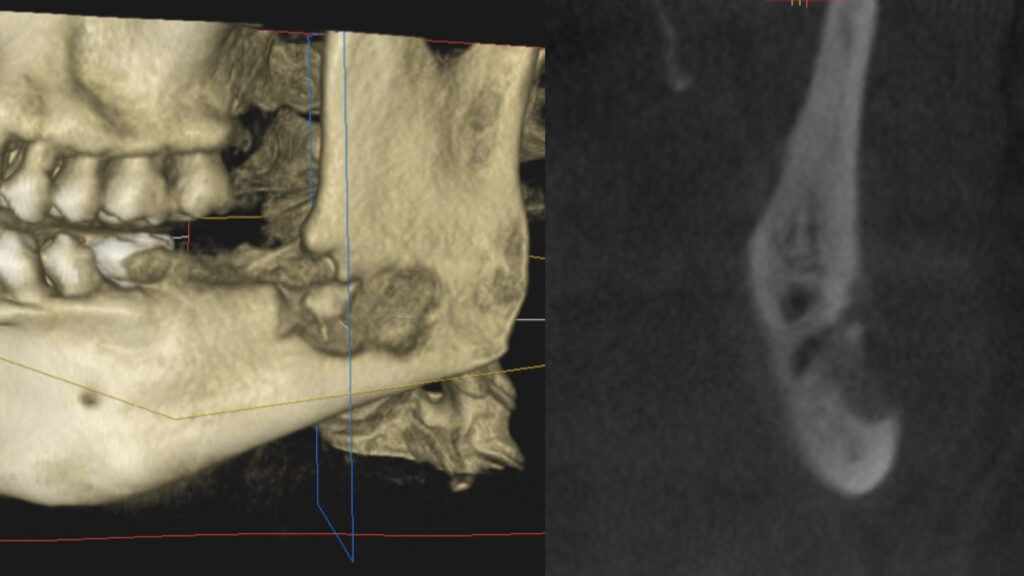Dental health is crucial for our overall well-being, but sometimes even routine procedures can lead to unforeseen complications. Osteomyelitis of the jaw is a severe condition that can arise from a traumatic tooth extraction. In this blog, we delve into a case where a tooth extraction lasting over three hours resulted in infection, further complicated by heavy smoking and a lack of patient communication and follow-up during the crucial healing phase.

Understanding Osteomyelitis:
Osteomyelitis is an infection of the bone that can occur in various parts of the body. When it affects the jawbone, it is referred to as osteomyelitis of the jaw. This condition typically arises from bacterial infections, and when left untreated, it can cause significant pain, swelling, and even lead to the destruction of the affected bone.
The Role of Lengthy and Traumatic Tooth Extraction:
In this particular case, the patient underwent a tooth extraction that extended well beyond the usual duration. Extraction of a deeply impacted wisdom tooth was attempted by an inexperienced dentist with invasive techniques that lasted over 3 hours. In the process, extensive bone was removed and soft tissue was traumatized. At the end the dentist was not able to extract the entire tooth and was told it will heal fine as is. Patient continued to experience pain and swelling for several days leading him to seek consultation with a specialist at our office. The remainder of the tooth was removed and patient was placed on antibiotics.
The lengthy and invasiveness of the initial tooth extraction was likely significant contributing factors to the subsequent development of osteomyelitis. Such circumstances increase the risk of infection due to prolonged exposure of the surgical site, damage to surrounding tissues, and compromise to the vascularity during healing. Furthermore, the invasive nature of the extraction creates an open wound, providing an entry point for bacteria to invade the bone.
Smoking: A Complicating Factor:
Another element that played a crucial role in this case was heavy smoking. Smoking has been well-documented to hinder the body’s natural healing process. The chemicals present in tobacco smoke constrict blood vessels, reducing blood flow to the surgical site. This compromised blood flow decreases the delivery of oxygen and essential nutrients to the area, hindering the body’s ability to fight off infection and heal properly. Smoking also inhibits Immunoglobulin A (IgA) which has been shown to be related to increased caries, periodontal disease, poor oral healing, and post-operative infections.
Lack of Patient Communication & Follow-Up:
After any dental procedure, close monitoring and follow-up care are vital for successful healing. In this case, the patient failed to adhere to the recommended post-operative care instructions and did not report his ongoing pain after the surgery for months. Regular check-ups allow dentists to evaluate the progress of healing, identify potential complications early on, and intervene promptly if necessary. The absence communication from the patient and proper follow-up care meant that the infection went unnoticed and untreated for an extended period, exacerbating the condition.
Prevention and Treatment:
Osteomyelitis of the jaw following a traumatic tooth extraction is a severe and preventable complication. Preventing complications like osteomyelitis requires a combination of factors. First, dentists must ensure that extractions are performed efficiently with minimally-invasive techniques, and minimize the duration of the procedure. Fore more complex procedures such as removal of impacted wisdom teeth, patients should see an oral and maxillofacial surgeon that specializes in such procedures. Patients should be educated about the risks associated with smoking and the importance of abstaining during the healing phase. Additionally, strict adherence to post-operative care instructions and regular follow-up appointments are crucial for identifying and treating any complications promptly. Treatment of osteomyelitis of jaw bone involves oral or IV antibiotics, surgical debridement and irrigation of the affected area, and close monitoring.
Dr. H. Ryan Kazemi is a board-certified oral and maxillofacial surgeon in Bethesda, MD